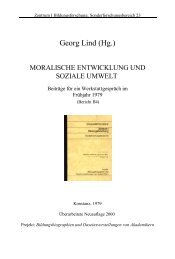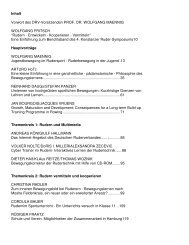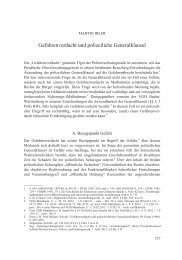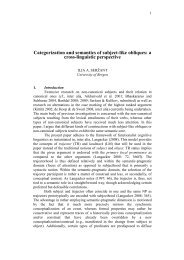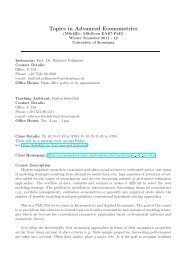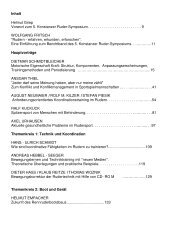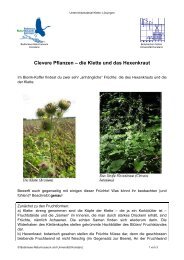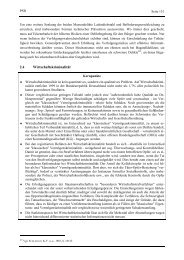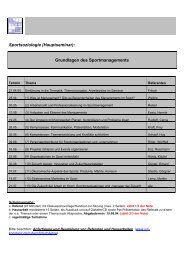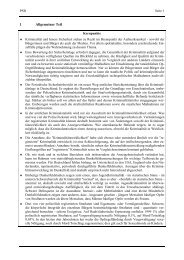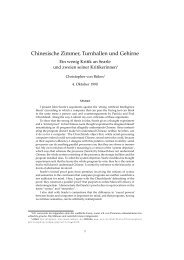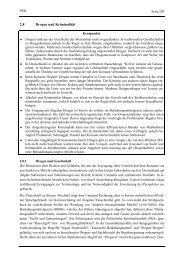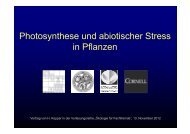Book of Abstracts Book of Abstracts - Universität Konstanz
Book of Abstracts Book of Abstracts - Universität Konstanz
Book of Abstracts Book of Abstracts - Universität Konstanz
Create successful ePaper yourself
Turn your PDF publications into a flip-book with our unique Google optimized e-Paper software.
B - 48<br />
96<br />
Carbon clusters for the calibration in mass spectrometry<br />
Alexander Herlert 1,2 , Sudarshan Baruah 1 , Klaus Blaum 3,4 , Michael Block 4 ,<br />
Ankur Chaudhuri 1 , Frank Herfurth 4 , Alban Kellerbauer 2 , H.-Jürgen Kluge 4 ,<br />
Gerrit Marx 1 , Mannas Mukherjee 4 , Lutz Schweikhard 1 , and Chabouh Yazidjian 2,4<br />
for the ISOLTRAP and SHIPTRAP collaboration<br />
1 Institut für Physik, Ernst-Moritz-Arndt-<strong>Universität</strong> Greifswald, 17487 Greifswald, Germany<br />
2 CERN, Department <strong>of</strong> Physics, 1211 Geneva 23, Switzerland<br />
3 Institut für Physik, Johannes Gutenberg-<strong>Universität</strong> Mainz, 55099 Mainz, Germany<br />
4 GSI, Planckstr. 1, 64291 Darmstadt, Germany<br />
The masses <strong>of</strong> radionuclides are <strong>of</strong> importance in a wide range <strong>of</strong> physics branches [1]:<br />
From nuclear structure studies to tests <strong>of</strong> the Standard model. Penning traps have proven to<br />
allow the mass determination <strong>of</strong> short-lived nuclides with a relative mass uncertainty <strong>of</strong> less<br />
than δm/m=1·10 -8 [2,3] and in case <strong>of</strong> stable nuclides even below 2·10 -11 [4,5].<br />
The principle <strong>of</strong> accurate mass measurements is based on the precise determination <strong>of</strong> the<br />
cyclotron frequency νc=qB/(2πm) <strong>of</strong> the stored ions in the trap. The experimental scheme<br />
monitors the gain in kinetic energy <strong>of</strong> the radial ion motion after excitation with a quadrupolar<br />
radi<strong>of</strong>requency field [6]. For the determination <strong>of</strong> the ion mass, the magnetic field needs to be<br />
calibrated. This is achieved with the measurement <strong>of</strong> the cyclotron frequency <strong>of</strong> an ion with<br />
well-known mass. Here, carbon clusters are the reference particles <strong>of</strong> choice. First, the mass <strong>of</strong> a<br />
12 C atom defines the atomic mass unit. Second, with respect to their mass, carbon clusters Cn are<br />
distributed like a grid on the chart <strong>of</strong> nuclides, where the maximum distance <strong>of</strong> any nuclide to a<br />
carbon cluster is six atomic masses.<br />
In addition, cross-reference measurements allow consistency checks. Thus, carbon clusters<br />
have been used to determine the systematic uncertainties in the mass determination <strong>of</strong> very<br />
short-lived nuclides [7] at the triple trap mass spectrometer ISOLTRAP [8] at ISOLDE/CERN.<br />
For these studies the clusters were produced by laser ablation from a Fullerene target [9]. A new<br />
carbon cluster ion source has recently been installed and will be tested for the upcoming beamtime<br />
period at ISOLDE/CERN. A similar cluster ion source is presently being installed at the<br />
mass spectrometer SHIPTRAP [10] at GSI, which is devoted to mass spectrometry <strong>of</strong> superheavy<br />
nuclides that are delivered from the mass separator SHIP. First results are presented.<br />
References<br />
[1] D. Lunney et al., Rev. Mod. Phys. 75, 1021 (2003).<br />
[2] G. Bollen, Eur. Phys. J. A 15, 237 (2002).<br />
[3] M. Mukherjee et al., Phys. Rev. Lett. 93, 150801 (2004).<br />
[4] R.S. van Dyck et al., Phys. Rev. Lett. 92, 220802 (2004).<br />
[5] S. Rainville et al., Science 303, 334 (2004).<br />
[6] M. König et al., Int. J. Mass Spectrom.Ion Proc. 142, 95 (1995).<br />
[7] A. Kellerbauer et al., Eur. Phys. J. D 22, 53 (2003).<br />
[8] F. Herfurth et al., J. Phys. B: At. Mol. Opt. Phys. 36, 391 (2002).<br />
[9] K. Blaum et al., Anal. Bioanal. Chem. 377, 1133 (2003).<br />
[10] G. Marx et al., Hyperfine Interact. 146/147, 245 (2003).



